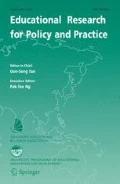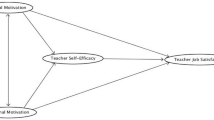Abstract
The purpose of this study is to better understand how math teachers’ effectiveness as measured by value-added scores and student satisfaction with teaching is influenced by school’s working conditions. The data for the study were derived from 2009 to 2010 Teacher Working Condition Survey and Student Perception Survey in Measures of Effective Teaching Project. Using the structural equation modeling and other related methods, several models of teacher effectiveness were estimated. The findings indicate that among the examined working condition factors, support for instruction and for student conduct management have significant effects on teachers’ value-added scores in mathematics. Moreover, the student satisfaction with teaching seems to have a mediating effect on value-added scores. The findings of the study significantly contribute to a better understanding of the effects of working environment on math teachers’ effectiveness and how improvement in working conditions can enhance math teachers’ performance.



Similar content being viewed by others
References
Aaronson, D., Barrow, L., & Sander, W. (2007). Teachers and student achievement in the Chicago public high schools. Journal of Labor Economics, 25, 95–135.
Allen, J. P., Pianta, R. C., Gregory, A., Mikami, A. Y., & Lun, J. (2011). An Interaction-Based Approach to Enhancing Secondary School Instruction and Student Achievement. Science, 333, 1034–1037.
Berry, B., Daughtrey, A., & Wieder, A. (2009). Teaching effectiveness and the conditions that matter most in high-needs schools: A policy brief. Carrboro, NC: Center for Teaching Quality. http://www.teachingquality.org/sites/default/files/Tch_effective_twc_final.pdf.
Berry, B., Daughtrey, A., & Wieder, A. (2010). Teacher effectiveness: The conditions that matter most and a look to the future. Carrboro: Center for Teaching Quality.
Bill & Melinda Gates Foundation. (2010). Working with teachers to develop fair and reliable measures of effective teaching: MET Project Research Paper.
Bill & Melinda Gates Foundation. (2012). Asking students about teaching: Student perception surveys and their implementation: MET Project Policy and Practice Summary. Seattle: Bill & Melinda Gates Foundation.
Byrne, B. M. (1998). Structural equation modeling with LISREL, PRELIS, and SIMPLIS: Basic concepts, applications, and programming. Mahwah, NJ: L. Erlbaum Associates.
Clotfelter, C. T., Ladd, H. F., & Vigdor, J. L. (2011). Teacher mobility, school segregation, and pay-based policies to level the playing field. Education Finance and Policy, 6(3), 399–438.
Cosner, S. (2011). Teacher learning, instructional considerations and principal communication: Lessons from a longitudinal study of collaborative data use by teachers. Educational Management Administration & Leadership, 39(5), 568–589.
Glazerman, S., Loeb, S., Goldhaber, D., Staiger, D., Raudenbush, S., & Whitehurst, G. (2010). Evaluating teachers: The important role of value-added. Washington, DC: Brown Center on Education Policy at Brookings.
Goe, L., Bell, C., & Little, O. (2008). Approaches to evaluating teacher effectiveness: A research synthesis. Washington: National Comprehensive Center for Teacher Quality.
Hanover Research (2013). Student Perception Surveys and Teacher Assessments, Washington, DC.
Hanushek, E. A. (1971). Teacher characteristics and gains in student achievement: Estimation using micro data. American Economic Review Papers and Proceedings, 61(2), 280–288.
Hanushek, E. A., & Rivkin, S. G. (2007). Pay, working conditions, and teacher quality. Future of Children, 17(1), 69–96.
Henson, R. K. (2001). Understanding internal consistency reliability estimates: A conceptual primer on coefficient alpha. Measurement and Evaluation in Counseling and Development, 34(3), 177–189.
Ingersoll, R. M., & Perda, D. (2009). The Mathematics and science teacher shortage: Fact and myth. Philadelphia, PA: University of Pennsylvania, Consortium for Policy Research in Education (CPRE) Research Report #RR-62.
Ingersoll, R. M., & May, H. (2012). The magnitude, destinations, and determinants of mathematics and science teacher turnover. Educational Evaluation and Policy Analysis, 34(4), 435–464.
Jackson, C. (2014). Are working conditions related to teacher effectiveness? 39th Annual conference of the association for education finance and policy. TX: San Antonio.
Jackson, C. K., & Bruegmann, E. (2009). Teaching students and teaching each other: The importance of peer learning for teachers. American Economic Journal: Applied Economics, 1(4), 85–108. doi:10.1257/app.1.4.85.
Johnson, S. M. (2006). The workplace matters: Teacher quality, retention, and effectiveness. Washington, DC: NEA Professional Library.
Johnson, S. M., Kraft, M. A., & Papay, J. P. (2012). How context matters in High-Need Schools: The effects of teachers’ working conditions on their professional satisfaction and their students’ achievement. Teachers College Record, 114(10), 1–39.
Jöreskog, K. G., & Sörbom, D. (2006). LISREL (version 8.80) [computer software]. Chicago: Scientific Software International.
Kane, T., & Staiger, D. (2008). Estimating teacher impacts on student achievement: An experimental evaluation. NBER Working Paper 14607, National Bureau of Economic Research, Inc.
Kyriakides, L. (2005). Drawing from teacher effectiveness research and research into teacher interpersonal behaviour to establish a teacher evaluation system: a study on the use of student ratings to evaluate teacher behaviour. Journal of Classroom Interaction, 40(2), 44–66.
Ladd, H. F. (2011). Teachers’ perceptions of their working conditions: How predictive of planned and actual teacher movement? Educational Evaluation and Policy Analysis, 33(2), 235–261.
Lance, C. E., Butts, M. M., & Michels, L. C. (2006). The sources of four commonly reported cutoff criteria: What did they really say? Organizational Research Methods, 9(2), 202–220.
Lankford, H., Loeb, S., & Wyckoff, J. (2002). Teacher sorting and the plight of urban schools: A descriptive analysis. Educational Evaluation and Policy Analysis, 24(1), 37–62.
Lockwood, J. R., & McCaffrey, D. (2009). Exploring student-teacher interactions in longitudinal achievement data. Education Finance and Policy, 4(4), 439–467.
Loeb, S., Darling-Hammond, L., & Luczak, J. (2005). How teaching conditions predict teacher turnover in California schools. Peabody Journal of Education, 80(3), 44–70.
Markley, T. (2006). Defining the effective teacher: Current arguments in education.
Nye, B., Konstantopoulos, S., & Hedges, L. V. (2004). How large are teacher effects? Educational Evaluation and Policy Analysis, 26, 237–257.
Oesterle, M. (2008). Student Perceptions of Effective Teaching. (Doctor of Education), ARIZONA STATE UNIVERSITY.
Raudenbush, S. (2013). What do we know about using value-added to compare teachers who work in different schools?. Stanford, CA: Carnegie Foundation for the Advancement of Teaching.
Raudenbush, S. W., & Bryk, A. S. (2002). Hierarchical linear models: Applications and data analysis methods (2nd ed.). Thousand Oaks, CA: SAGE Publications.
Rivkin, S. G., Hanushek, E. A., & Kain, J. F. (2005). Teachers, schools, and academic achievement. Econometrica, 73(2), 417–458.
Rockoff, J. (2004). The impact of individual teachers on student achievement: Evidence from panel data. American Economic Review: Papers and Proceedings of the One Hundred Sixteenth Annual Meeting of the American Economic Association, 94(2), 247–252.
Sanders, W., Wright, W., & Horn, S. (1997). Teacher and classroom context effects on student achievement: Implications for teacher evaluation. Journal of Personnel Evaluation in Education, 4(1), 3–7.
Sass, T., Hannaway, J., Xu, Z., Figlio, D., & Feng, L. (2012). Value added of teachers in high-poverty schools and lower poverty schools. Journal of Urban Economics, 72(2–3), 104–122.
Schumacker, R. E., & Lomax, R. G. (2010). A beginner’s guide to structural equation modeling. Mahwah, NJ: Lawrence Erlbaum Associates.
Wenglinsky, H. (2000). How teaching matters: Bringing the classroom back into discussions of teacher quality. Princeton, NJ: The Milken Family Foundation and Educational Testing Service.
White, M., & Rowan, B. (2014). User guide to measures of effective teaching longitudinal database. The University of Michigan.
Author information
Authors and Affiliations
Corresponding author
Rights and permissions
About this article
Cite this article
Ye, Y., Singh, K. The effect of working condition on math teacher effectiveness: value-added scores and student satisfaction in teaching. Educ Res Policy Prac 16, 283–295 (2017). https://doi.org/10.1007/s10671-016-9207-6
Received:
Accepted:
Published:
Issue Date:
DOI: https://doi.org/10.1007/s10671-016-9207-6



